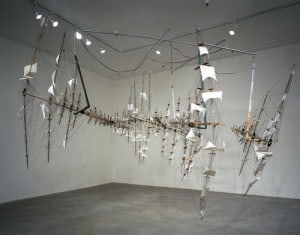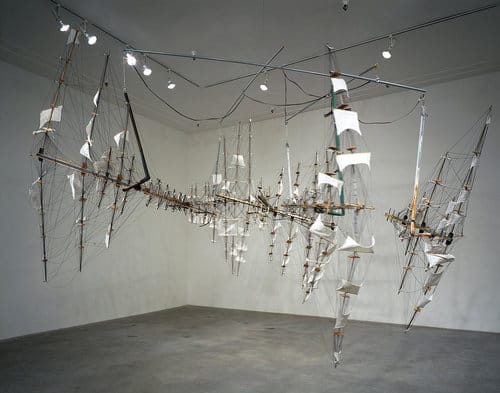
Mashups of technology and art are all the rage these days. Recently San Jose saw downtown turn into a wild street demonstration of art, technological innovations and music with the SubZERO festival. And that trend continues. Today, the San Jose Museum of Art announced it will present, in connection with the upcoming 2010 01SJ Biennial, an exhibition that “grapples with the technological cult of the new and questions the notion of obsolescence.”
“As a year-round anchor of the arts in downtown San Jose and an institutional partner of ZERO 1, the San Jose Museum of Art is pleased to participate again in the 01SJ Biennial,” said Susan Krane, Oshman Executive Director of SJMA. “Retro-Tech is the first of three exhibitions SJMA is presenting for the biennial, including the Leo Villareal, the artist’s first museum survey, and Vital Signs, an installation of major new media works in the permanent collection. The international conversation generated by the 2010 01 SJ Biennial brings great energy to San Jose and greater awareness of the collective cultural climate here.”
The exhibition, called Retro-Tech, will be on view July 22, 2010, through February 6, 2011, and will feature recent work by an international array of artists, including Jennifer Allora and Guillermo Calzadilla (Puerto Rico), Katya Bonnenfant (Lyon, France), Tim Hawkinson (Los Angeles), Aleksandra Mir (Palermo, Italy), Camille Scherrer (La Tour-de-Peilz, Switzerland), Madeln (Xu Zhen) (Shanghai), and Ricardo Miranda Zúñiga (New York) as well as new commissions by San Francisco-based Rebar (Blaine Merker, John Bela, and Matthew Passmore) and Scott Kildall and Victoria Scott (also of San Francisco). Under the thematic umbrella of the 2010 01SJ Biennial, “Build Your Own World,” the artists in Retro-Tech re-purpose and reinterpret technologies of the past and often draw on craft and folk traditions. Retro-Tech explores the tension between primitive and advanced technologies and encourages a longer historical perspective on the 21st-century love of the latest and greatest technology.
“The San Jose Museum of Art has been a core cultural partner since the inaugural 01SJ Biennial in 2006,” said Joel Slayton, executive director, ZER01. “To provide our partners with a direct stake in the creation and outcome of the Biennial, for 2010 we created a curatorial participatory model. Retro-Tech represents the museum’s contribution, which provides a compelling view of the intersection of art and technology while complementing the Biennial theme. We also look forward to the museum’s parallel programming, particularly the dynamic Villareal exhibition.”
“The artists represented in Retro-Tech manipulate technologies of the past and present in ways that range from to ironic to analytical,” said Kristen Evangelista, associate curator at SJMA and a member of the 01SJ Biennial Curatorial Team. “As they explore the ‘craft’ of technology, they often investigate the very notion of obsolescence. Here, with the benefit of our 21st-century hindsight, the historical course of technology becomes a vehicle for understanding both our present context and our visions for an augmented future.”
Several of the artists in Retro-Tech look to traditional handcraft and folk art from diverse cultures, then add new technologies to the mix to comment on contemporary life. For example, the collaborative team of Jennifer Allora and Guillermo Calzadilla (based in Puerto Rico) use the tulum, an ancient musical instrument found in the Kackar Mountains of Turkey, in their film There is More Than One Way to Skin a Sheep (2007). In it, a tulum player re-purposes his instrument to inflate a flat bicycle tire on a busy Istanbul street. In Vagamundo: A Migrant’s Tale (2002), Ricardo Miranda Zúñiga explores the plight of undocumented workers in New York through a 1980s-style video game housed inside an ice cream cart, hand built in the style of paleteros (Latino ice-cream vendors). French artist Katya Bonnenfant houses new technology in outdated cases, as if the old were inhabited by the new. For example, her “Vintage Packaging for Animation” (2009) is a series of small animations enshrined in vintage calculators and clocks.
Tim Hawkinson also reuses found materials in Aerial Mobile (1998), in which he meticulously intertwines television antennae with string and rope to construct a towering work resembling a ship-in-a bottle. Hawkinson explores vestiges of defunct technology: 19th-century ocean exploration vessels and 20th-century communication devices.
The duo of Scott Kildall and Victoria Scott (based in San Francisco) are represented by more than 20 small sculptures from their series “No Matter“ (2008), for which they built paper versions of mythical and imaginary objects created in the online virtual community Second Life. In addition, Kildall and Scott will construct a large Trojan Horse, based on one of the diminutive “imaginary” works from No Matter. Gift Horse will be constructed during a series of public workshops in the San Jose Convention Center’s South Hall, site of the 2010 01 SJ Biennial’s exhibition Out of the Garage Into the World. Participants are invited to make small paper sculptures that will fill the body of the horse, which will later be “smuggled” ceremoniously from the South Hall into the Museum to become a populist part of Retro-Tech.
In her series of collages “On the Moon” (2009), Aleksandra Mir juxtaposes religious icons like saints and angels with images of space travel. Camille Scherrer creates a magical world in Le Monde des Montagnes (2008). As the viewer turns the pages of an ordinary book, playful projected animations appear.
SJMA has commissioned Rebar to create a new public project for Retro-Tech. Rebar is an interdisciplinary design studio based in San Francisco, whose principle members are Blaine Merker, John Bela, and Matthew Passmore. For Farmcycle (2010), Rebar uses a common mechanical technology for storing kinetic energy, the flywheel, and basic bicycle parts to create this prototype of a pedal-powered alternative to the fossil-fuel driven tractor.


